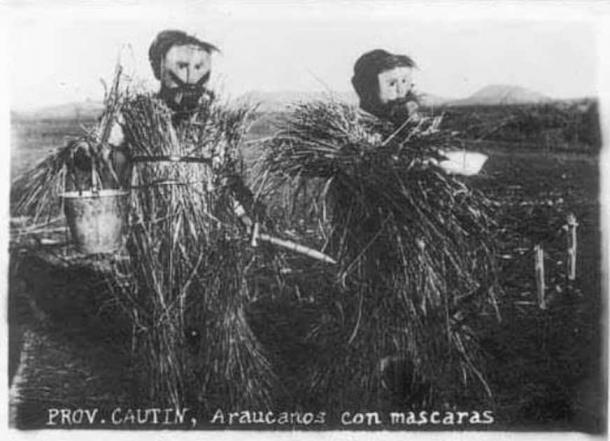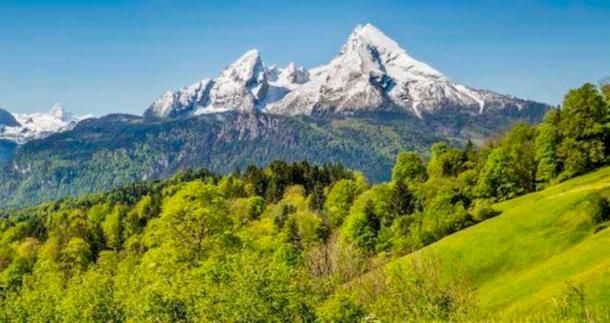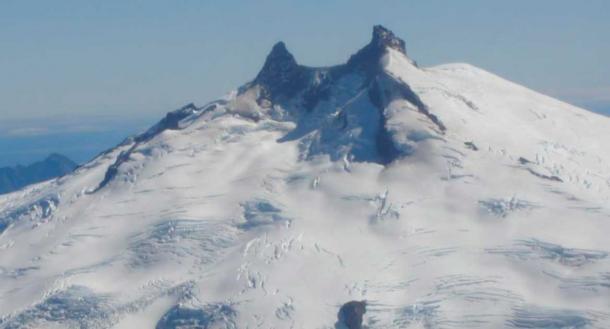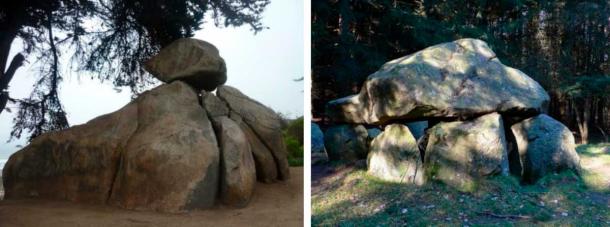
From Araucanía, Chile to Berchtesgaden, Germany - A Remote Connection?
Significantly, the magical-religious “attire” of the tradition of ancient Araucania and the now disappeared Araucanians of the south-central and southern zone of Chile are related to the pagan Buttnmandl tradition of southern Germany, specifically the Berchtesgaden Valley. The distance between these two similar clothing styles is greater than 12,770 km (7,935 miles).
Is it a coincidence that an Andean people of Chile and the Berchtesgaden people of Bavaria, Germany wore similar magical-religious clothing? Or was there an unknown connection between the two regions?
Chilean Araucanians Linked To Bavarian Berchtesgarteners?
The “attire” of the Araucanians is characterized by constituting a kind of straw clothing that covers the entire body. The Buttnmandl celebrants, a pagan tradition to drive out winter, even though much of the contemporary German celebration is wrapped in Christian themes.
- The Alien Petroglyphs of Chile’s Valle del Encanto
- Araucanian “Staircase to Heaven” Symbolism in the Pre-Hispanic World
As in the representations of the Araucanians, some of the Buttnmandl costumes have horns. In this sense, and in relation to the symbolism of the horns in the pre-Christian pagan tradition, Professor Roberto Rengifo has pointed out that horns are symbols of gods and heroes.

Araucanians with masks and ceremonial garments from the Province of Cautín, in the Region of Araucanía, in southern Chile (Photograph by Gustave Millet, ca. 1930, courtesy of the author Rafael Videla Eissmann)

The Buttnmandl of southern Germany and Austria. The similarity with the masks and garments worn by the Araucanians is unmistakable (Unknown photographers, no date / courtesy of the author, Rafael Videla Eissmann).

The imposing Berchtesgaden Alps, center of the sacred tradition of the ancient Germans. The highest peak is known as Watzmann (Wotan-Odin) and the second is Watzmannfrau or “Watzmann’s Wife.” (Photograph courtesy of the author, Rafael Videla Eissmann)

The sacred Melimoyu volcano in Patagonia, in the Region of Aysén, in the extreme south of Chile. According to mythical tradition, in its vicinity is the City of the Caesars, known also as Elelín and Trapananda, the ancient Kingdom of the Giants. (Photograph courtesy of the author, Rafael Videla Eissmann)
Strange Facial Hair From Completely Different Peoples?
It is striking to note that these Araucanian representations wore the Kollón, or masks characterized for the most part by beards and mustaches, racial factors alien to the indigenous populations of proto-Mongoloid and Mongoloid origin from Asia.
- Critically Endangered South American Forests were Planted by Ancient Peoples
- Chile’s SuperGran Is Last Living Keeper Of A 10,000-Year-Old Language and Culture
Here again –albeit indirectly– the evidence of a population completely different from the indigenous “indios” is evidenced in their sacred masks. This is a fact that must necessarily be of importance to archaeologists and anthropologists today because it directly addresses the dogmas of official historiography regarding the origin of American humans, their stages of cultural development, and the chronology of their settlement.

The Kollón or Araucanian masks. They are representations of bearded men, a racial factor generally absent in the phenotypes of indigenous populations of the Asian Mongoloid group. These are evocations of the original inhabitants of the territory of Chile, that is, of the white Indians (Respectively: Detail of a photograph taken by Gustave Millet around 1930 in Cautín, Chile; a photograph by Fernando Maldonado; Photographic Archive of the Museo Histórico Nacional de Chile; Museo Chileno de Arte Precolombino; Domeyko Cassel Collection in the Museo Mapuche de Cañete).
But what is the origin of these representations in Araucanía? What was their name? What was the meaning and function of these figures? How did they originate? What was the initial model from which these representations were made in southern Chile? What magical-religious rite did they belong to? Is there still an Araucanian source that has preserved the knowledge of these representations?
Araucanian masks refer to their ancestors, that is, to the Antupainko, the Children of the Sun: The primordial Andean beginnings, the dolichocephalic population of America about which no one dares to write. The forbidden history!

The sacred symbol of the Sun of the Araucanians. The Kultrún or magic drums, stamped with the symbol of Antü ( ), this is, the Sun in movement –the revered τετρασκέλιον (Tetraskélion), the Swastika, in variations of four and six arms–. In the Kultrún and according to what was communicated by Quinturay Raypán, these ideographs evoke the succession of the suns or ages on the circle that is equivalent to the Mapu or earth (Illustrations by José Pérez de Arce).

The sacred symbol of the Sun of the Germans. a. The symbol in a runic engraving found in Martebo, Gotland, in Sweden. b. A gold brooch with the Tetraskélion, from the Island of Fyen, Denmark. c. The Tetraskélion in a disk brooch, from Germany. d. A magic-religious object found in Cologne, Germany. (Photos courtesy of the author, Rafael Videla Eissmann)
The Remote Connection Between The Andes And The Alps
This similarity allows us to glimpse a remote connection between the Andes and the Alps, sacred mountain ranges in the traditions of the primordial dolichocephalic groups of both regions.
But how to explain the connection of these representations with the Buttnmandl? Where is its origin ultimately found, is it in Chile or in Germany, or even in another region?
- The Return of the Moai: Rapa Nui and the Fight for its Ancestors
- Pumas, Cougars And Jaguars: Feline Deities Of Prehistoric South America
It is plausible to intuit a source from which this representation has arisen and has survived in the Berchtesgaden Valley and its syncretism with Christian elements, but not so in Araucanía, where the sacred and initiatory tradition of the Araucanians was interwoven with the Sun and the great Clovis Comet Impact catastrophe around 12,900 years ago.
These are the echoes of a forbidden history that may well explain these bizarre connections as opposed to just odd coincidences.

Left: Dolmen in the coastal town of Rocas de Santo Domingo, in the Region of Valparaíso, in Chile. It is called “Idol of the Viewpoint of the Gringo” (Photograph by Rafael Videla Eissmann, 2018). Right: A Hünengrab, or megalithic grave called Teufelsofen –“Devil’s Oven”– in the Evershäger Forest, in Mecklenburg-Western Pomerania, Germany (Unknown photographer, no date).
Top image: Descendants of Araucanians with ceremonial attire and bearded masks –Kollón– from Cautín in the Region of Araucanía, in southern Chile. These representations are strikingly similar to the Buttnmadl of the Berchtesgaden Valley in southern Germany. Source: Gustave Millet, ca. 1930, courtesy of the author Rafael Videla Eissmann
By Rafael Videla Eissmann
References
Dowling Desmadryl, Jorge. 1971. Religión, chamanismo y mitología mapuche. Editorial Universitaria. Santiago de Chile.
Faron, Louis. 1969. Los mapuches. Ediciones Especiales 53. México.
Foerster, Rolf. 1991. Aproximaciones a la religiosidad mapuche contemporánea. Centro Ecuménico Diego de Medellín. Santiago, Chile.
Foerster González, Roelf. 1993. Introducción a la religiosidad mapuche. Editorial Universitaria. Santiago de Chile.
Guevara, Tomás 1902. Historia de la civilización de la Araucanía. Imprenta Cervantes. Santiago de Chile.
Guevara, Tomás. 1908. Psicolojía del pueblo araucano. Imprenta Cervantes. Santiago de Chile.
Guevara, Tomás. 1911. Folklore araucano. Refranes, cuentos, cantos, procedimientos industriales, costumbres prehispanas. Imprenta Cervantes. Santiago de Chile.
Guevara, Tomás. 1913. Las últimas familias i costumbres araucanas. Litografía i Encuadernación Barcelona. Santiago de Chile.
Guevara, Tomás. 1916. La mentalidad araucana. Sociedad Imprenta Litografía Barcelona. Santiago de Chile.
Gunkel Lüer, Hugo. 1965. El origen del hombre americano según el naturalista chileno Juan Ignacio Molina. Boletín de la Universidad de Chile. Santiago de Chile.
Medina, José Toribio. 1910. El descubrimiento de Chile por los frisones en el siglo XI. Memorias Cientificas i Literarias. Imprenta de Cervantes. Santiago de Chile.
Robles, Rodríguez. 1940. Eulogio Costumbres y creencias araucanas (1911). Anales de la Universidad de Chile. Santiago de Chile.
Videla Eissmann, Rafael. 2007. Roberto Rengifo y el Secreto de la América Aborigen. El papel del territorio de Chile en la evolución de la humanidad prehistórica y el origen polar antártico del hombre. Editorial Puerto de Palos. Santiago de Chile.
Videla Eissmann, Rafael. 2015. Símbolos rúnicos en América. El regreso a la tierra ancestral (2011). Editorial Abya Yala. Quito.
Videla Eissmann, Rafael. 2014. Los lituches. Los hombres-dioses de la tradición del sur del mundo. Ediciones Tierra Polar. Santiago de Chile.
Videla Eissmann, Rafael. 2017. Antártida, Arquinesia y la Atlántida. Aproximaciones al poblamiento americano. Ediciones Tierra Polar. Santiago de Chile.
Videla Eissmann, Rafael. 2017. Irminsul. Simbolismo en torno al origen de la raza polar. Ediciones Tierra Polar. Santiago de Chile.
Videla Eissmann, Rafael. 2013. Das uralte Wissen der Mapuche. Fliegender Berg und Himmelsleiter. Sagenhafte Zeiten. Beatenberg, Switzerland.
Videla Eissmann, Rafael. 2020. Himmelsleitern in der vorspanischen Welt: Von Rehue bis Kuxa’an Suum. Sagenhafte Zeiten. Beatenberg, Switzerland.
Videla Eissmann, Rafael. 2020. Símbolos cósmicos en los emblemas de poder de los antiguos araucanos de Chile. La tradición sagrada de los antupainko. Unpublished. Santiago de Chile.
















Comments
There were undoubtedly historical European or, more likely, Indo-European migrations that are not yet acknowledged sufficiently, because their acceptance may be inconvenient to modern social engineering, including to South America.
History shouldn't be afraid to step on political toes. History should be concerned only with the truth. This article does its bit towards that end and the author and the site editor are to be commended for it.
Going by the fact that they possessed a lot of metal objects and yet had no metal-working capabilities (upon the Spaniards’ arrival) definitely suggests there was an earlier, advanced culture before them, which was likely also responsible for the stonework. Whatever killed the big animals like the Mastodons (possibly also causing the Ice Age) might have also wiped out the people of that earlier culture, leaving just their bones, the ruins, and the non-ferrous metal objects to be claimed.
Nobody gets paid to tell the truth.